A H NAIX AICILA F R ANKOVICH ANNE ECALLAW LUCIA N DUERF ANONYMOUS B R OOK A NDREW CASSIL S CL AIRE L A EBM GEORGIABA N SK J UANDAVILA LEIG H EWOB YR MATTHEWDA V I S AGEM N COPE SIHT YAW MIKE P A RR S A MNESRETEP THEKI L GNIL YHONN I E ECRACS Agent Bodies 08.04.22 — 14.08.22
Anonymous Brook Andrew Georgia Banks Leigh Bowery Cassils Megan Cope Juan Davila Matthew Davis Alicia Frankovich Lucian Freud The Killing Claire Lambe Mike Parr Sam Petersen Yhonnie Scarce Anne Wallace Ah Xian
Agent Bodies
Artists
RMIT Culture is proud to present Agent Bodies at RMIT Gallery, continuing our series of provocative thematic exhibitions celebrating unique RMIT research. The curators, Associate Professor Mikala Dwyer and Dr Drew Pettifer from RMIT’s School of Art, seek to enable a better understanding of what a body is by bringing together contemporary creative practices that question themes of agency, power and identity.
We live inside our own bodies every day. However, how often do we stop to consider how entwined they are with our identity and our world? This is a timely consideration as so much of the contemporary body’s agency is continuously being subjected to political will and power. The works in this exhibition do just this.
This exhibition is made possible by the generosity of many artists and donors who have kindly allowed us to bring works from their collections together. In particular, we would like to acknowledge our appreciation of Margery King, Curator of the Leigh Bowery Estate, for generously lending works of Leigh Bowery, a former RMIT student. There are also works from RMIT’s own Art Collection, including works by Brook Andrew, Juan Davila and Ah Xian. It is always a joy to see these on display as part of new research which continues to enhance our understanding, interpretation, and appreciation of these works.
I warmly thank Tom Bentley, Executive Director Policy and Impact and Vice Chancellor’s Innovation Professor, and Adam Seedsman, Executive Director, Business Development and Partnerships for enabling RMIT Culture’s continued success in delivering high-quality programming. As always, I must express my gratitude to the RMIT Culture team, in particular the exhibitions, production and collections staff and casuals who work within RMIT Gallery and across the University to foster the development of creative projects like this one. It is their hard work and dedication that make it possible to bring you this remarkable exhibition.
by Paula Toal Head, RMIT Culture
3
Foreword
Agent Bodies
5 Curators’ Essay by Mikala Dwyer and Drew Pettifer 10 Agent Bodies, Bodies’ Agency by Susan Best 14 New Mutants by Edward Colless 22 Biographies 32 Credits 40 Contents
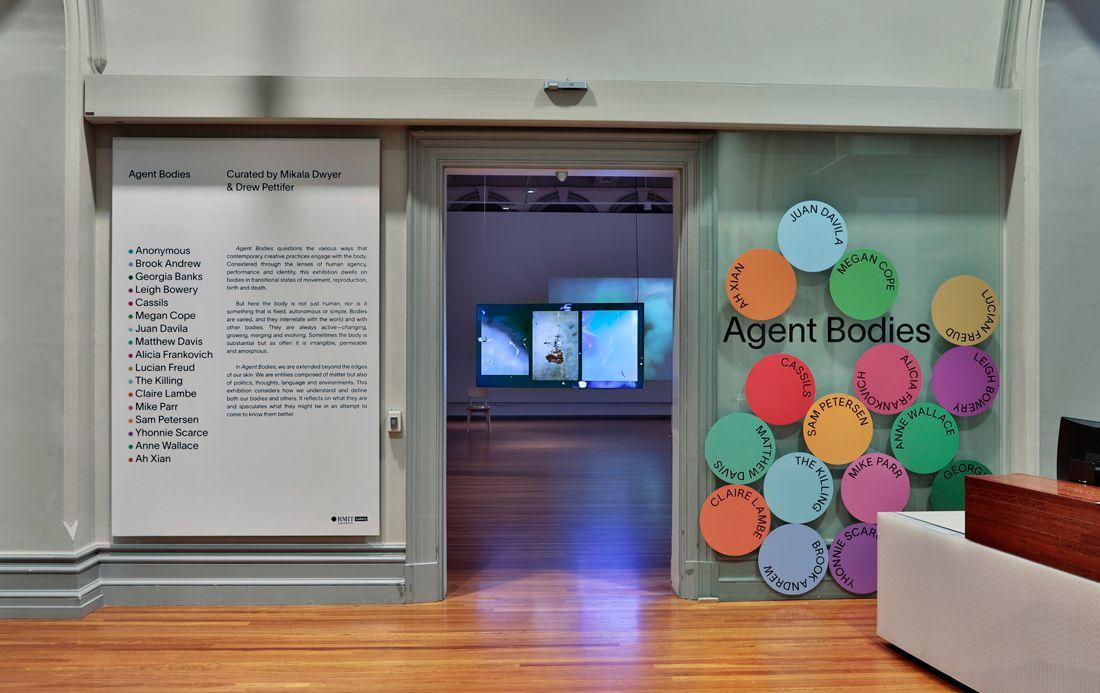

Bodies
Agent
(top) Installation image, Agent Bodies, 2022, RMIT Gallery.
(bottom) Claire Lambe, I Just Can’t Help Myself, 2020-2021, bronze sculpture. Image courtesy of the artist, and Sarah Scout Presents.

7
Ah Xian, China, China - Bust 78, 2002, porcelain with celadon glaze. Image courtesy of the RMIT Art Collection.
 Agent Bodies
Installation image, Agent Bodies, 2022, RMIT Gallery. Image includes works by Yhonnie Scarce, Lucian Freud, Leigh Bowery, Sam Peterson, Megan Cope, Alicia Frankovich, and Brook Andrew.
Agent Bodies
Installation image, Agent Bodies, 2022, RMIT Gallery. Image includes works by Yhonnie Scarce, Lucian Freud, Leigh Bowery, Sam Peterson, Megan Cope, Alicia Frankovich, and Brook Andrew.

9
Mikala Dwyer & Drew
Pettifer
Curators’ Essay
“The gross and net result of it is that people who spend most of their natural lives riding iron bicycles over the rocky roadsteads of this parish get their personalities mixed up with the personalities of their bicycle as a result of the interchanging of the atoms of each of them, and you would be surprised at the number of people in these parts who nearly are half people and half bicycles.”1
What do we mean when we talk about “bodies” today? It seems that we’ve moved so far beyond ideas of the singular body/self, more readily acknowledging the blurry lines between bodies and the spaces around them. We now recognise that our bodies are engaged in constant processes of transformation or becoming; as you read this essay you are shedding old cells and growing new ones. The human body is constantly engaging with and sometimes colliding with other living and non-living bodies; this includes material bodies, energetic bodies, and even technological bodies. As Karan Barad writes, “human bodies, like all other bodies, are not entities with inherent boundaries and properties but phenomena that acquire specific boundaries and properties through the openended dynamics of intra-activity.”2 In addition to these
shifts in how we might materially perceive the body to be, our understanding of social and cultural bodies has also been revolutionised. Bodies are increasingly understood as intersectional and hybrid and identities as fluid and diverse. With this in mind, how can we approach understandings of bodies in the contemporary moment? Where are the edges now?
Agent Bodies does not propose an answer to these uncertainties, but instead seeks to find the relevant questions. Agency is one framework we’ve proposed for approaching these issues. Agency raises questions around how much control we have over those processes and how much power or influence we have over the body. Is there a body—or even part of a body—that fully retains its own agency today? What would complete agency look like? There are certainly bodies and parts of bodies that resist colonisation or control, but how do we identify and understand them? Which cells can be free of the command of other cells that have been controlled by external forces?
Agency is always relational to other bodies and other forms of what Michel Foucault referred to as “biopower”.3 This reminds us that bodies exist in a social context amid collective bodies and collective selves. For us as curators, Agent Bodies often alludes to a kind of body with a
Agent Bodies
superpower, a figure that is empowered and possesses agency. We think all of the artists in this show have a unique superpower when it comes to their framing of the agent body. Some take an ethereal approach to the body—almost mournful or haunted—while others integrate the body with the atmosphere or with its environment. Across this exhibition, themes of life and death and sex abound. We see allusions to dead bodies, to unborn bodies and to very new bodies with new identities. The bodies included in this exhibition also comprise different forms of matter; they are gaseous, metallic, liquid, soil, oil.
This project is a speculative experiment to see what happens when a cross-section of artworks addressing contemporary bodies are placed together in an exhibition space. What does the exhibition conjure and what does it reveal? What happens when different kinds of agency are brought together? How do they manifest and how do they interact? This project does not predetermine responses to any of these questions; instead, it proposes the exhibition format as a means of generating an unfolding dialogue between various bodies, including the artists’,
the artworks’, and the viewers’. Agent Bodies is a site for reflection, a place in which to consider processes of bodily reconfiguration, recontextualisation, and reinterpretation. And as these processes themselves take time, it should be no surprise that the works and their various embodied exchanges might only reveal themselves to the viewer over time or after revisiting.
This exhibition was created to question the various ways that contemporary creative practices engage with themes of human agency, performance, identity, and the body. Considering new propositions of what a body is, what it has been, and, perhaps most importantly, what it could be, this exhibition interrogates how human bodies, nonhuman bodies, and the space between bodies are today contextualised and understood. These excesses of the body highlight the ‘extra-human’ nature of contemporary identities. Many of the artists included in Agent Bodies recognise bodies as fluid, hybrid, permeable, and ambiguous. They explore how bodies dictate the shape of time and space, but also how the shape of time and space can influence bodies. They reflect on where the body is, where it isn’t, and the various states in between.
by Mikala Dwyer and Drew Pettifer
1 O’Brien, F. (1967). The third policeman. London: Hart-Davies, MacGibbon.
2 Barad, K. (2007). Meeting the Universe Halfway: Quantum Physics and the Entanglement of Matter and Meaning. Durham & London: Duke University Press, p. 172
3 This term coined by the French philosopher Michel Foucault refers to the techniques for achieving the control of populations and the subjugation of bodies. Foucault, M. (1976). The History of Sexuality Volume 1: An Introduction. Paris: Éditions Gallimard, p. 140.
11
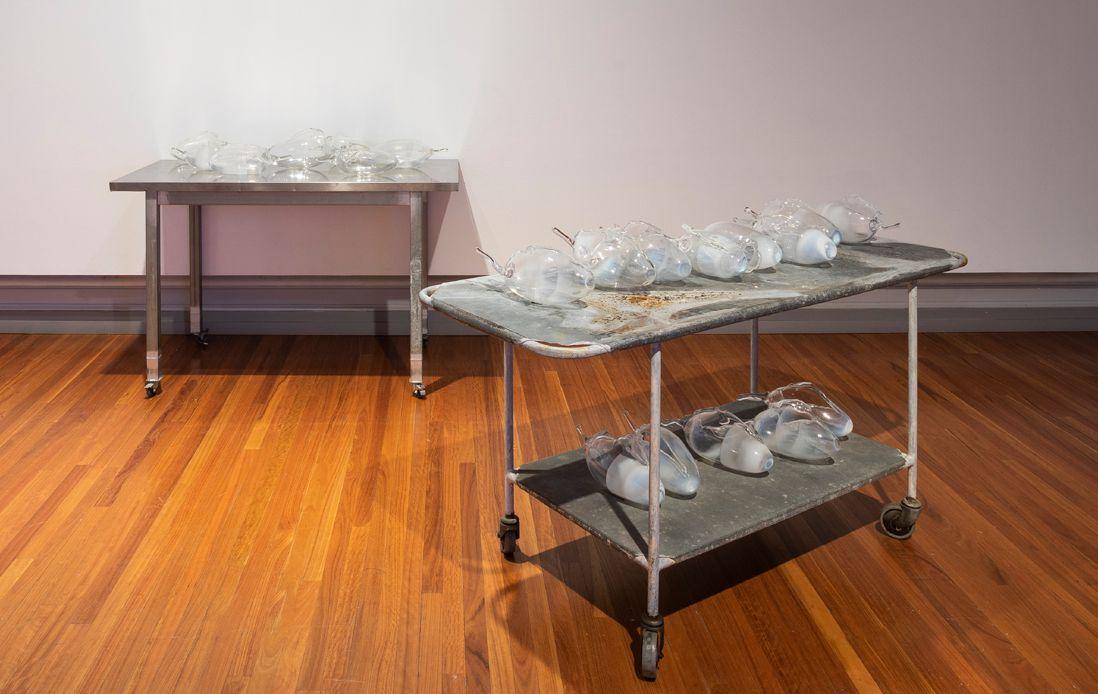

Agent Bodies
(top) Yhonnie Scarce, In the dead house, 2020, hand-blown glass bush bananas, and vintage mortuary trolley. Image courtesy of the artist, and THIS IS NO FANTASY. (bottom) Yhonnie Scarce, In the dead house (detail), 2020, hand-blown glass bush bananas, and vintage mortuary trolley. Image courtesy of the artist, and THIS IS NO FANTASY.
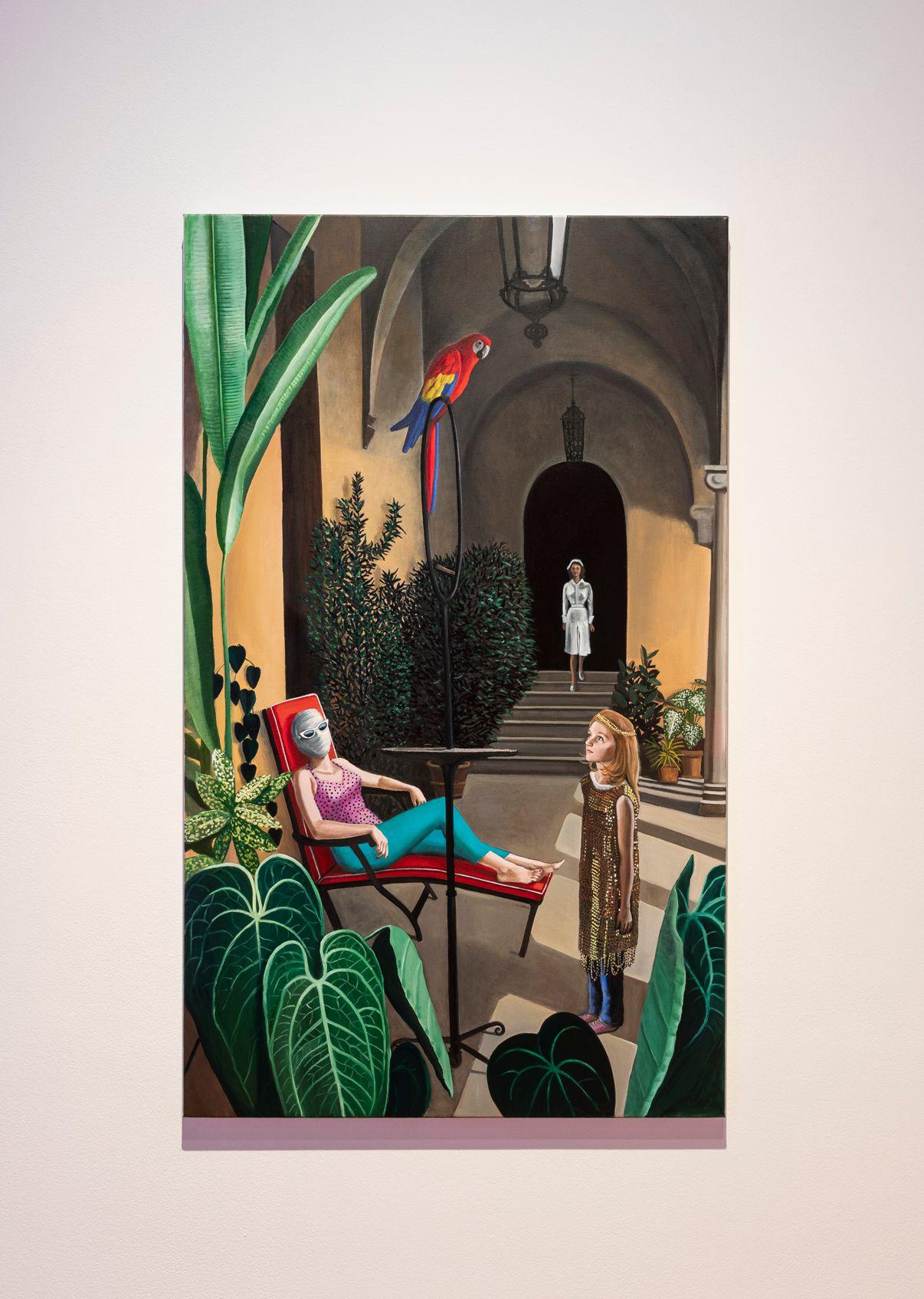 Anne Wallace, Infanta, 2021, Oil on linen. Image Courtesy of the artist, and Darren Knight Gallery.
Anne Wallace, Infanta, 2021, Oil on linen. Image Courtesy of the artist, and Darren Knight Gallery.
Agent Bodies, Bodies’ Agency
“A thread runs from Duchamp to Cage to Forti and is part of the larger story of modernism. All share a common strategy I can only name as ‘agency reduction.’ … I think the strategy of agency reduction extends beyond aesthetic issues. Underlying it are ethical doubts about legitimacy itself, which poses the question: In the face of the nightmare that was the twentieth century, how is the agent to act, and what can justify and authorize his or her actions? It should come as no surprise that this skepticism of authority should reverberate in aesthetic practices.”1
by Robert Morris
American minimalist artist Robert Morris wrote this account of the reduction of agency in 2012 on the occasion of the fiftieth anniversary of the Judson Dance Theatre (the New York venue closely associated with the rise of deskilled inexpressive dance). Art responds to a nightmarish world, Morris suggests, by a kind of withdrawal or reduction of the artist’s agency and presence. Elsewhere, I have called this desire to reduce the presence of the artist a quest for a kind of impersonality in modern and contemporary art. 2
The desire to make impersonal art takes many forms. Indeed, artists have developed a remarkable range of strategies to try to achieve this paradoxical goal of self-expression that communicates self-effacement. For example, they have used serial or modular methods and chance operations, deployed task-like actions, and questioned classical composition by aiming at what YveAlain Bois calls “non-composition”—the avoidance of compositional choices by minimising decisions.3 Other techniques include the revelation of the medium, using
readymade objects and already-made compositions, collective production, delegated production and performance, the inclusion of audience participation and of course appropriation. These are just some of the ways in which artists have sought to reject or reduce personal expression across the twentieth century.
The evacuation of the artist and conventional conceptions of the self and the body are even more prescient today in a world of such profound uncertainty. Our nightmarish anxiety-inducing COVID-19 present similarly leads to a suspicion of authority. This uncertain moment is the context for the exhibition Agent Bodies curated by Melbourne-based artists Mikala Dwyer and Drew Pettifer. The exhibition asks us to think deeply about states of embodiment under conditions of precarity, and to reconsider fundamental questions like: what are bodies? how do they survive and thrive? what do they desire? and most importantly, what are their limits and entanglements?
Included in the exhibition is an extraordinary work by Leigh Bowery that throws these questions about embodiment into very sharp relief. It is a video documenting his performance at Wigstock 1993, New York’s annual dragfest in Tomkins Square Park. It begins with him singing the Beatles’ hit ‘All you need is love’ completely encased in a costume that conceals his face and, as it turns out, another body. The performance ends with Bowery giving birth to that other body, his wife Nicola Bateman. The shock of the work and the persona he invents is still incredibly fresh today. One of the best accounts of Bowery’s inventiveness comes from curator William Lieberman. He said: “The extraordinary thing was that it was never drag—it was really a costume … I mean, he wasn’t trying to imitate or personify anyone else. He was simply creating a new being.”4 This impulse towards creating new styles of being and embodiment can be seen in other works in the exhibition by artists such as Cassils, Megan Cope, Alicia Frankovich, Claire Lambe, Yhonnie Scarce, Sam Petersen and the New Zealand art collective, The Killing.
Agent Bodies
Susan Best
Alongside this thinking about bodies, there is a profound interrogation of artistic agency—what it serves and how it might be questioned. For example, at the extreme end of this questioning of artistic agency one of the works in the exhibition is deliberately authorless. The curators, of course, know who has authored the work, it is a newly commissioned work for the exhibition, but the artist does not want their identity attached to the work. The deliberate production of an anonymous work of art is highly unusual in Western art. This is usually regarded as an undesirable state that should be redressed if at all possible. Here, instead, that state is desired, shifting the focus to the orphaned work of art. Another work Remains To Be Seen (2021) by Georgia Banks deals even more literally with the death of the author. Using the format of a mock reality TV competition, Banks offers the viewer the opportunity to organise, or as journalist Nick Miller puts it, to “curate” her funeral.5 Skeins by Matthew Davis also addresses death, specifically the results of nuclear testing in the Woomera Prohibited Area, South Australia and the ongoing threat of nuclear annihilation. His evocative sound work includes interviews with historians and museum workers about the proliferation of weapon production along with field recordings of the wind through the children’s cemetery in Woomera where the effects of radiation poisoning, particularly on the Indigenous population is very evident.6
Other artists use different means to reduce the presence of the artist’s person or personality, such as the artistic strategy of appropriation in the case of Anne Wallace, Ah Xian, Juan Davila and Brook Andrew. The deliberate quotation of the visual language of others makes artistic expression much less direct. The use of the body as brute material that often characterises early performance art, including the work of Mike Parr, is another method of downplaying the egoistic self. This sheer physicality is refigured by Cassils. Their work reminds us of the scant attention actually paid to the physicality of the body by that pioneering generation. Recall how we looked at unappealing things like the “pimply back” of Vito Acconci, to cite Lucy Lippard.7 Cassils takes seriously the task of
forming images. The astonishing sculpting of the body’s musculature is reframed to embrace visuality and spectacle. The actions of that body are also turned to collective purpose in works such as Monument Push (2017). In this film, a bronze cast of clay residue from a performance is pushed through the streets of Omaha by a group of participants. This collective action, a tribute to the LGBTQ+ history of the city, models community-mindedness and a kind of selflessness. Such an ethical stance combined with openness to new ways of being speaks to the kinds of bodies we need right now.
That openness to the unknown along with acknowledgement of dependency on others cuts across typical accounts of personal autonomy and agency. In other words, subjectivity in this exhibition is conceived as porous, entangled and contingent. Minimising the egoistic self, as Robert Morris so clearly saw, allows the healthy questioning of actions and authority. In this way, the impersonal strategies of agency reduction we know from minimalism and conceptualism are reinvented to address our present conditions of uncertainty and precarity.
by Susan Best
1 Robert Morris, Interview by Lauren O’Neill-Butler, “Judson at 50: Robert Morris,” Artforum (December 31 2012) https://www.artforum.com/interviews/judson-at-50robert-morris-38415 accessed 30 December 2021
2 Susan Best, It’s not personal: Post 60s Body Art and Performance (London: Bloomsbury, 2021).
3 Yve-Alain Bois, “The Difficult Task of Erasing Oneself: Non-Composition in Twentieth-Century Art,” Institute for Advanced Study, March 7, 2007 https://video.ias. edu/The-Difficult-Task-of-Erasing-Oneself accessed 5 January 2022
4 Lieberman cited in Hilton Als, “Life as a Look,” The New Yorker March 30, 1998 https://www.newyorker.com/magazine/1998/03/30/life-as-a-look accessed 5 January 2022
5 Nick Miller, “Dying for immortality, this artist wants you to dispose of her body,” Sydney Morning Herald, April 22 2021 https://www.smh.com.au/culture/art-anddesign/dying-for-immortality-this-artist-wants-you-to-dispose-of-her-body20210422-p57le9.html accessed 5 January 2022
6 For information about the cemetery see https://uraniumthesilentkiller.wordpress.com/ woomera-cemetery/ accessed 16 February 2022.
7 Lucy Lippard, ‘The Pains and Pleasures of Rebirth: European and American Women’s Body Art’ (1976), The Pink Glass Swan: Selected Feminist Essays on Art (New York: The New Press, 1995), 102.
15
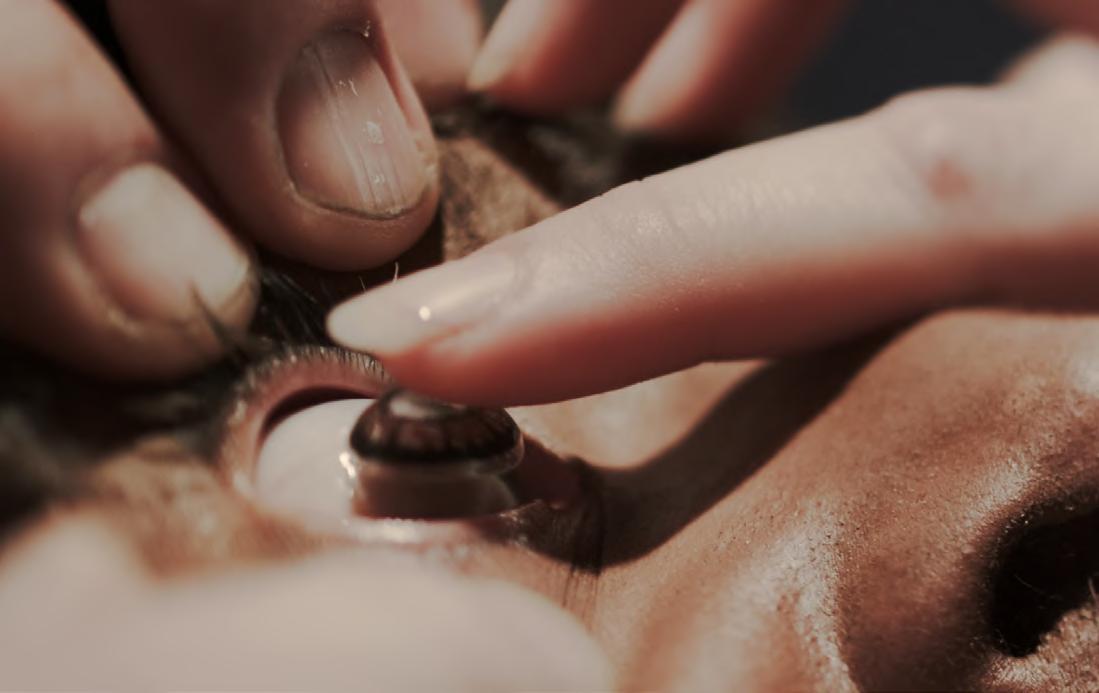
 Agent Bodies
(top) Megan Cope, THE BLAKTISM (still), 2014, digital video. Image courtesy of the artist, and Milani Gallery.
(bottom) Anne Wallace, Pythoness (detail), 2022, oil on linen. Image courtesy of the artist, and Kalli Rolfe Contemporary Art.
Agent Bodies
(top) Megan Cope, THE BLAKTISM (still), 2014, digital video. Image courtesy of the artist, and Milani Gallery.
(bottom) Anne Wallace, Pythoness (detail), 2022, oil on linen. Image courtesy of the artist, and Kalli Rolfe Contemporary Art.
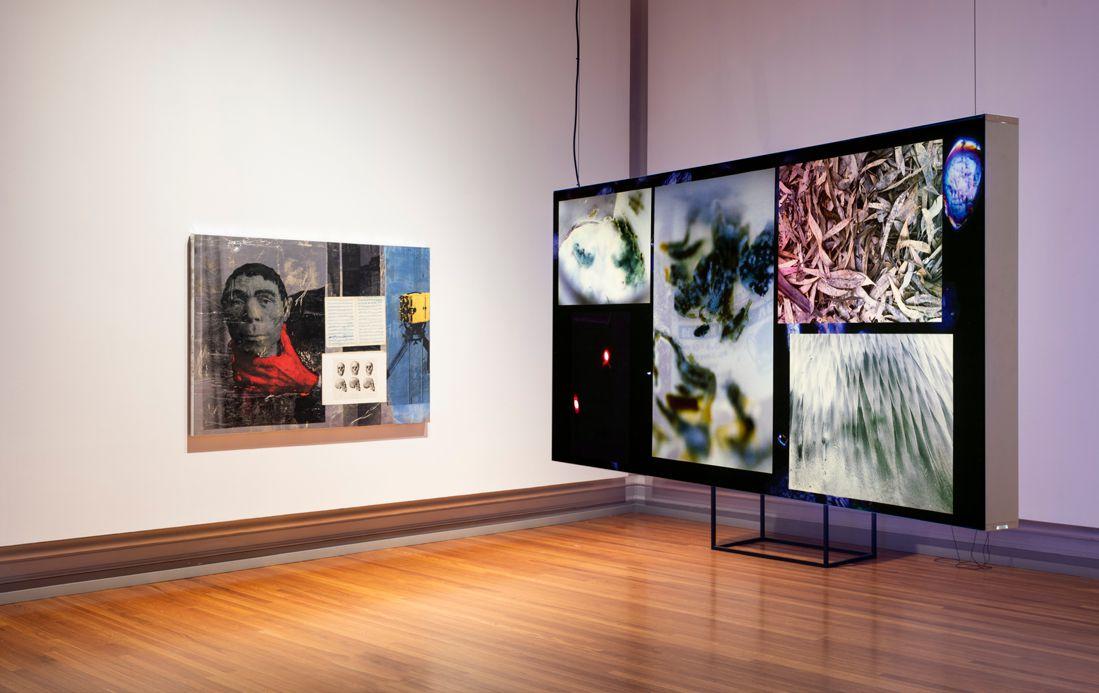
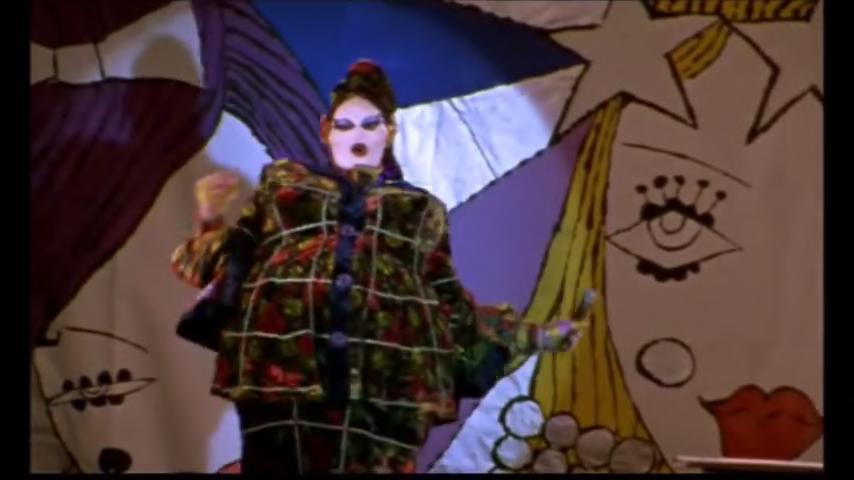
17
(top) Installation image, Agent Bodies, 2022, RMIT Gallery. Image includes works by Brook Andrew, and Alicia Frankovich.
(bottom) Leigh Bowery, Leigh Bowery performs at Wigstock 1993 (still), 1993, video.

Agent Bodies
Brook Andrew, The Language of Skulls, 2018, screenprint, and collage on canvas. Image courtesy of the RMIT Art Collection.

19
Juan Davila, (left) The Field, 1988, screenprint. (right) Pre-Modern Self Portrait, 1988, screenprint. Printing: Larry Rawling. Image courtesy of the RMIT Art Collection.
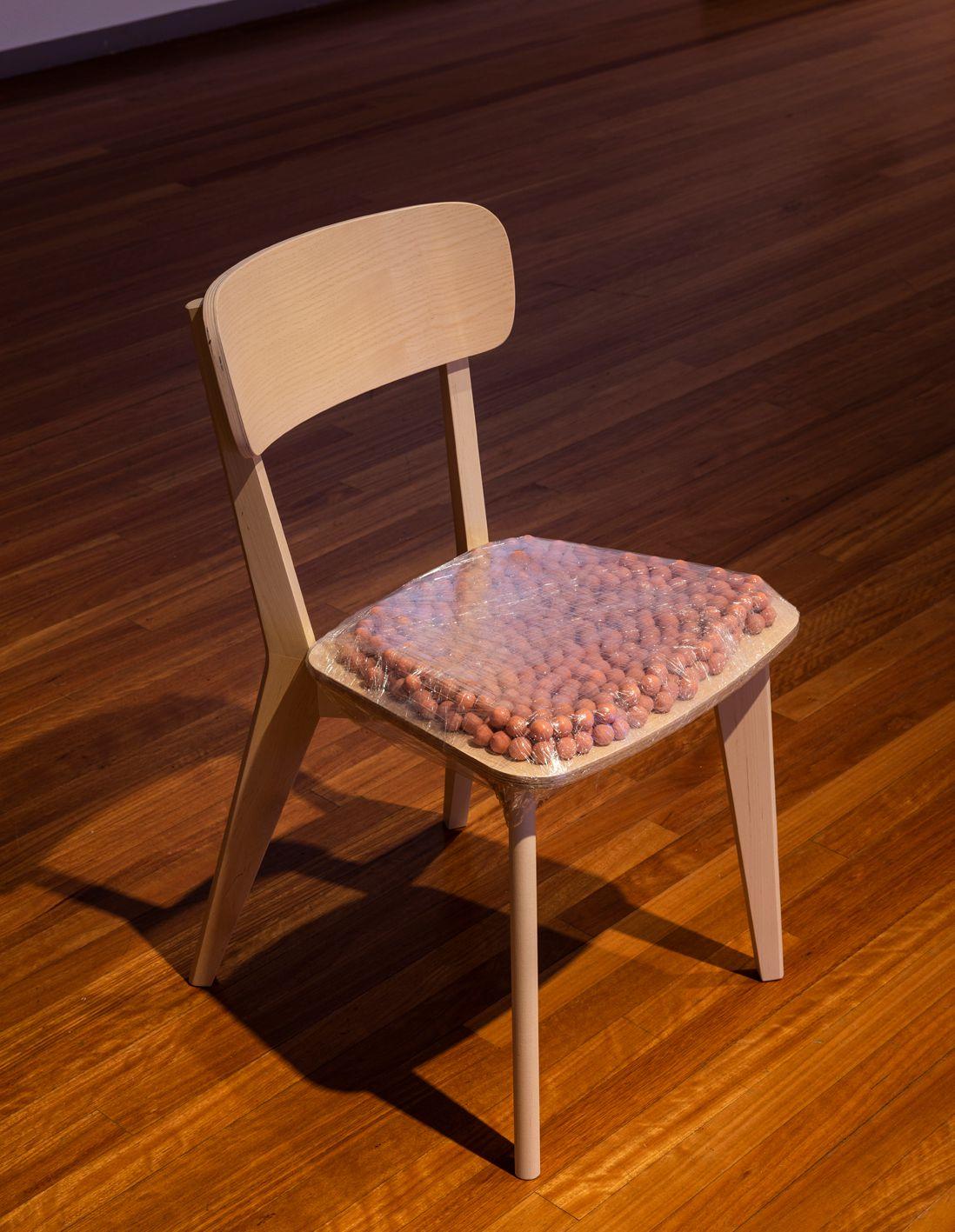 Agent Bodies
Sam Petersen, Just Sit, 2022, chair, plasticine, and plastic.
Agent Bodies
Sam Petersen, Just Sit, 2022, chair, plasticine, and plastic.
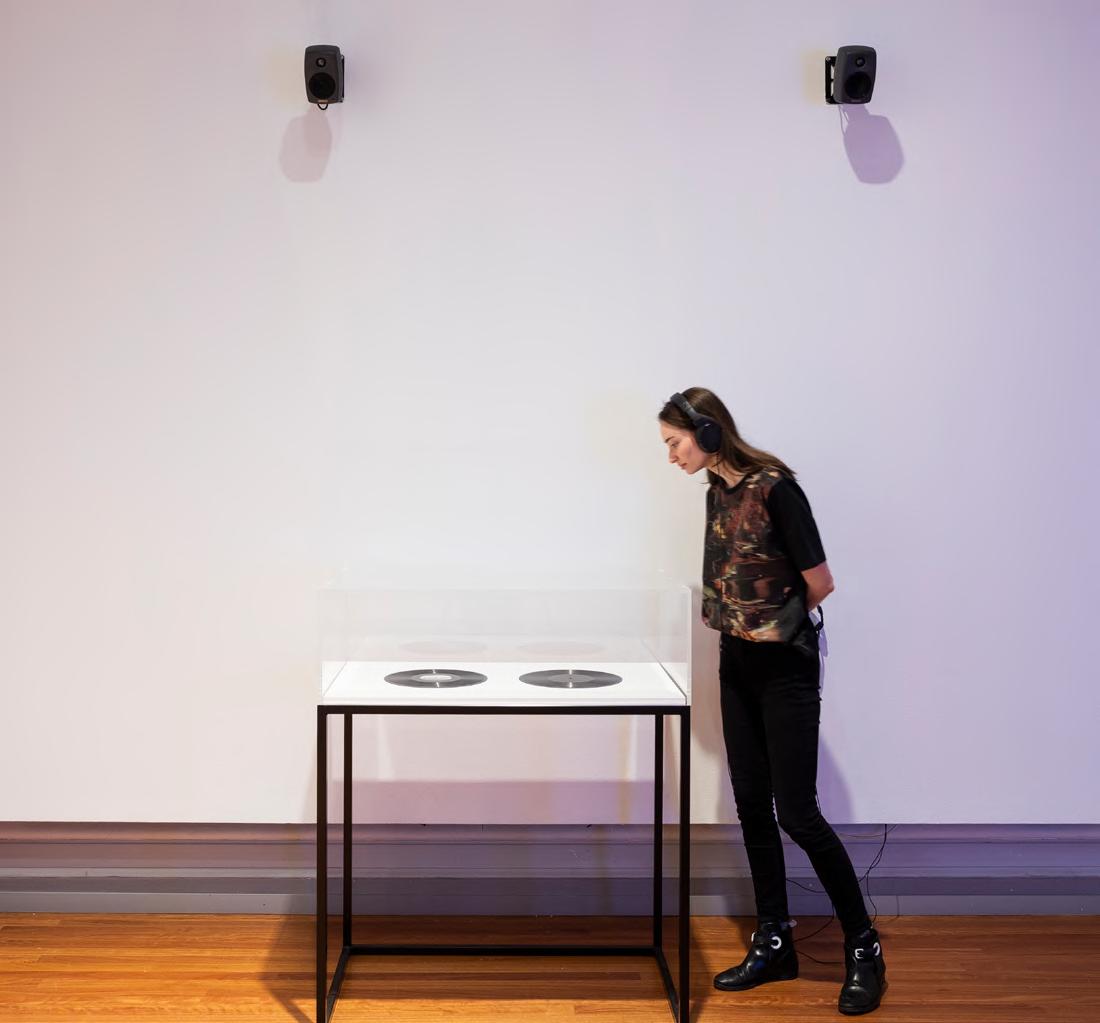

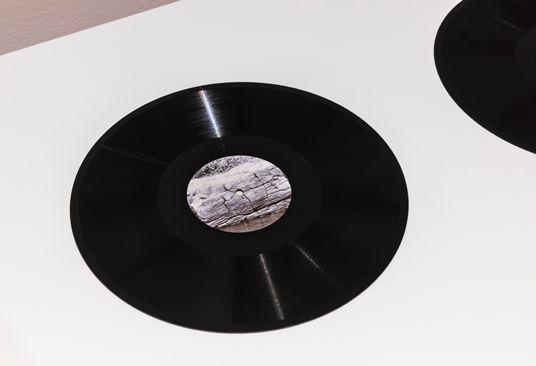
21
(top) Matthew Davis, Skeins, 2018-2021, stereo sound installation, digital audio interviews, vinyl records, speakers, and headphones.
(left) Sam Petersen, Just Sit (detail), 2022, chair, plasticine and plastic. (right) Matthew Davis, Skeins (detail), 2018-2021, stereo sound installation, digital audio interviews, vinyl records, speakers, and headphones.
New Mutants
“Agent” and “body” are two words that in combination could surely metatag, perhaps precis, the cultural preoccupations of the era we’ve called—interminably it feels now, for what … a couple of decades?—the Contemporary. Of course, on its own, the “body” word has been around for so long it’s starting to take on the wasted, maybe carnivorous, appearance of a zombie. At the least, it feels a bit worn out. The term “agent” has a pedigree too; and, if its philosophical bloodline through concepts of political “agency” and new materialism (now rather old hat) is far less sluggish, it’s become compromised if not enervated throughout the COVID-19 lockdowns, even looking a tad anaemic. But don’t think these old-school mantras are out of action. Like ancient spells, they still have a magic and an appealing threat— especially when, in this curatorial conjunction, they forge the fevered parentage of some demonic hybrid offspring.
In visual art, the vogue for “the body” (in step with the voguing of the body), spectacularly emerged with the pedagogical eclipse of the genre of “the nude” and its critical denunciation as sexual commodity, subjugation and spectacle. By the end of the twentieth century the nude and the life classes that trained artists in this genre—if you ever stumbled across them—were rare and discredited
atelier relics, as problematic as those stolen skeletons in the closets of anthropology museums. The statuesque or petrified protocols of life class were displaced by anarchic “liveness” and the bodily acting out of identities, appetites, regressions, transgressions, perversions, sensualities, therapeutics, and so forth (words admittedly now soaking in passé passion). This acting out was in order to play or present—rather than portray or represent—those extreme dignities and indignities (as well as different pleasures) of subjectivities othered by heteronormative societal construction. The agency in this embodied acting out prioritised all things performative over any things representational (active rather than reactive), granting a licence for exhibitionistic and ritualistic modes of ferocious exposure, as well as often inspiring inventions of sexual or mythic personae, cosplay, and fantasies of bionic evolution, or nightmares of cyborgian and genetic engineering.
But let’s face it. In retrospect, those generations of insubordinate, iconoclastic polymorphous, diversely performative bodies in visual art often appear to have been enjoying—passively or aggressively—an impetus strangely similar to the less fractious but equally militant imperatives of performance-enhancement in other modes of cultural capitalism. Bodies that enhance their own agential desiring as well as their acrobatic desirability proliferated new customisations that became the commodified lifestyling of gym-core and wellness bodyconscious marketing, of professional sports and reality TV or Instagram stardom. In one respect, performativity in the visual arts is compelled to tilt, theoretically if not practically in its taste for the uncompromised, toward the sort of envelope-pushing horizons of extreme and endurance sports, of body modification or Dionysian clubbing. Maybe also there’s the lure of Jackass contrariness and bravado, scandalising behavioural norms. Maybe too the gaming conceit of designing, conjuring and adopting superhero, or supermonstrous, avatars. In any respect, difference— whether through divergence or diffraction, in the meatverse or the metaverse—can be capitalised upon.
Agent Bodies
Colless
Edward
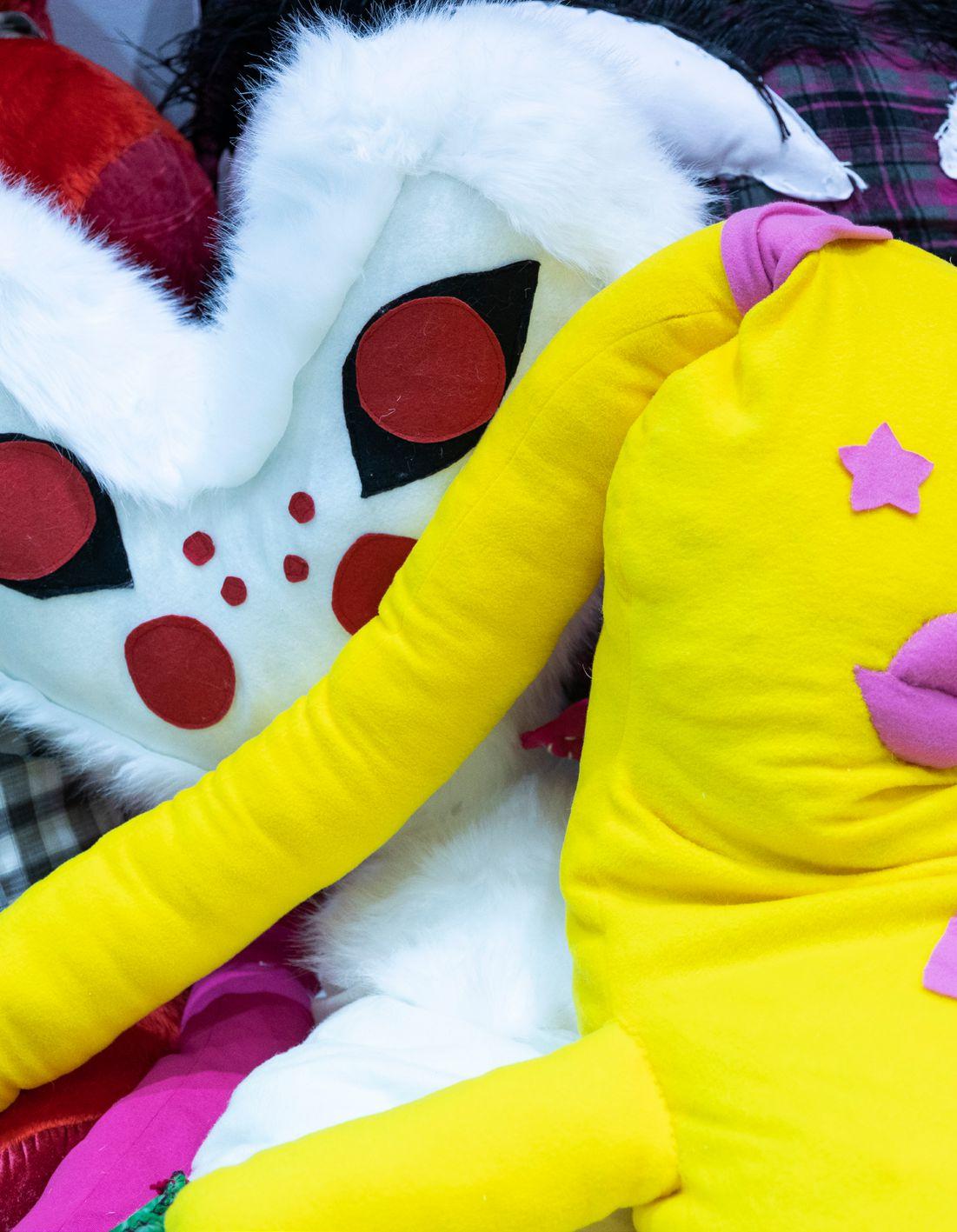
23
The
Killing, 6-Pack (detail), 2022, mixed textiles, and synthetic fibres.
New Mutants cont.
One strand in this cultural capitalisation of body agency is the validation of performance through the metrics of its indicators: subjective experiences of happiness and wellness in workplaces are now as much indicators of performance as is the more objective calculation of productivity; they too have decimal-point scales of measurability and compliance. The regular workplace performance review, often punitive under the guise of being pastoral, is the managerial simulation of a subjectivity that requires incessant upgrading of its performance in order to stay in the same place, even if the incentive is promotion. Of course, the “subject”—which was the stake, even if in simulation, in that “acting out” that drove postmodern performance toward a global cultural diagnosis and critique (everything cultural is now performative, no longer the province of subcultures)—that word and concept of the “subject” is now, too, an anachronism: “actants” are the smart upgrades for “subjects”. Actants are agents that are neither subjects nor objects because they are in constant engagement with the other, constantly modifying and being modified, affecting and being affected by the other. Unlike subjects or objects, actants engage by means of horizontal alliances or by configuring flat assemblages as clusters of agential affect. Indeed, “engagement” as a managerial imperative is itself a smart upgrade of “performativity”; just as “effectivity”—that measure of success in engagement as opportune operability—is the managerial upgrade of older industrial labour optimised as “efficiency”.
But, like much else in the global geopolitical landscape, what seemed to be unshakeable certainties in the lexicon of the Contemporary and its curatorial management of identity micropolitics have been dislocated by the tectonic shift that has occurred with the COVID pandemic. Both “body” and “agency” have revalued their currency due to the culture war between two political aggregations: on one hand, the spectrum of governmental public health policies
for containment through lockdown, vaccination and mask mandates; and, on the other, the social media mobilisation of so-called libertarian, sovereign-citizen and wellness conspiracy theory fuelled defiance of alleged governmental overreach (often alarmingly adopting the language of leftwing biopolitical critique).
Omicron has been the smart upgrade not only of the virus but of neoliberal economic strategy in this culture war, adjusting COVID’s performance indicators to measure it as an endemic rather than pandemic illness, and “letting it rip” through populations to contrive the statistics of herd immunity. Regardless of the specious epidemiology behind this ruse, we are encountering a new formulation of body agency. The unregulated flows of internet “virality” once celebrated in cultural studies (and marketing campaigns) as an emancipation from hegemonic itineraries and editorial protocols of cultural production have now become the exemplar for disinformation, social media echo-chambers and tracking consumer data-exhaust. “Tentacularity”, promoted as the cool epitome of a decentred and unrestricted dispersal of the sensorium or as the graphic form of the web’s neural networks, is being haunted in the COVID era by its Lovecraftian, ancestral psychic horror.
Now, no-one escapes the tentacular stealth of the virus. The only difference to be monitored is not whether you have the virus nor don’t have it (that statistic no longer matters), but whether you are hospitalised and die from it. Or die with it, adjacent to it, so it is an indirect morbidity. Universal self-monitoring requires, at its extremity, an exclusionary inequity with the anxiously self-imposed hermetic isolation or shielding conducted by those who are vulnerable—with “underlying health conditions” or “compromised immune systems”—to Omicron’s allegedly “mild” effects.
Agent Bodies


25
(top and bottom) Georgia Banks, Remains to be Seen (still), 2021. Image courtesy of the artist.
New Mutants
The Malthusian and eugenic Squid Game conducted in Australia notably by the NSW and Federal governments privatises public health policy to pivot the responsibility of pandemic management onto individuals: that’s to say, those economically free to choose their own responses to the pandemic, according to the supply—and lack or market scarcity—of what’s needed for that response.
In this scenario, body agency is rebadged as a private responsibility for delimiting the public effect of contagion, the spread of which paradoxically is actively encouraged in a transition to COVID-normal social and economic behaviour. A tidemark for transition will be when testing for COVID attains the value of a tax deduction. Ironically, the slogans that urge our bodies to “live with it” and “push through” COVID reduce it to a personally treatable illness (comparable to paracetamol for a headache), and yet also acknowledge it as an incurable universal infection. Rather like calling global warming “climate change”, the target of “living with it”—or dying with it rather than from it, in the current Orwellian Newspeak—is to render that pronoun “it”, the unmentionable virus, undetectable. And, thus, its population effects unpreventable. We now seem far from the cartography of “groupuscules” and nomadism. One might say that if this obscure, yet lethal, totalising condition assumes the scale of a hyperobject (to promiscuously steal Timothy Morton’s word), then its indiscernible infectious quarry might be called a hypersubject.
Let us imagine how the art and culture that have thrived on body agency throughout the Contemporary era (which we might as well now historically assign as “preCOVID”, ending when the motors of global exchange and marketing went into lockdown), imagine how this culture might evolve … entangled or in assemblage with the virus as it undergoes its inevitable variation and evolutionary opportunistic adaptations, its upgrades. As with the virus,
the next variant of concern in art will not be an adjustment or modification, not a revision or conversion—these will only be the equivalents of acclimatisation to the contagion, like tuning up aircon or ventilation to match local hotter temperatures—but will be a mutation. Mutation is an innovative rift in normal genetic activity. It can be an alien intrusion. It can be an irreversible disruption by deletion, substitution or insertion of code that can be damaging and catastrophic, yet which can also warp the body’s conduct into resistance to disease or as an evolutionary leap. It can be engineered, or it can appear as a mistake or by accident. In any of these cases, the agent in the dramaturgy of mutation is a dark and unidentified experiment; and whether its incitement and effects are human or non-human, it dissembles and disassembles. Regardless of its origin and motive, it has the dark and cryptic aspect of a miracle. With the game changing advent of COVID and the end of the Contemporary, the actant as the performer in cultural assemblies is superseded by the mutant erupting from a pandemic. Oh perilous upgraded world, that has such creatures in it.
by Edward Colless
Agent Bodies
cont.
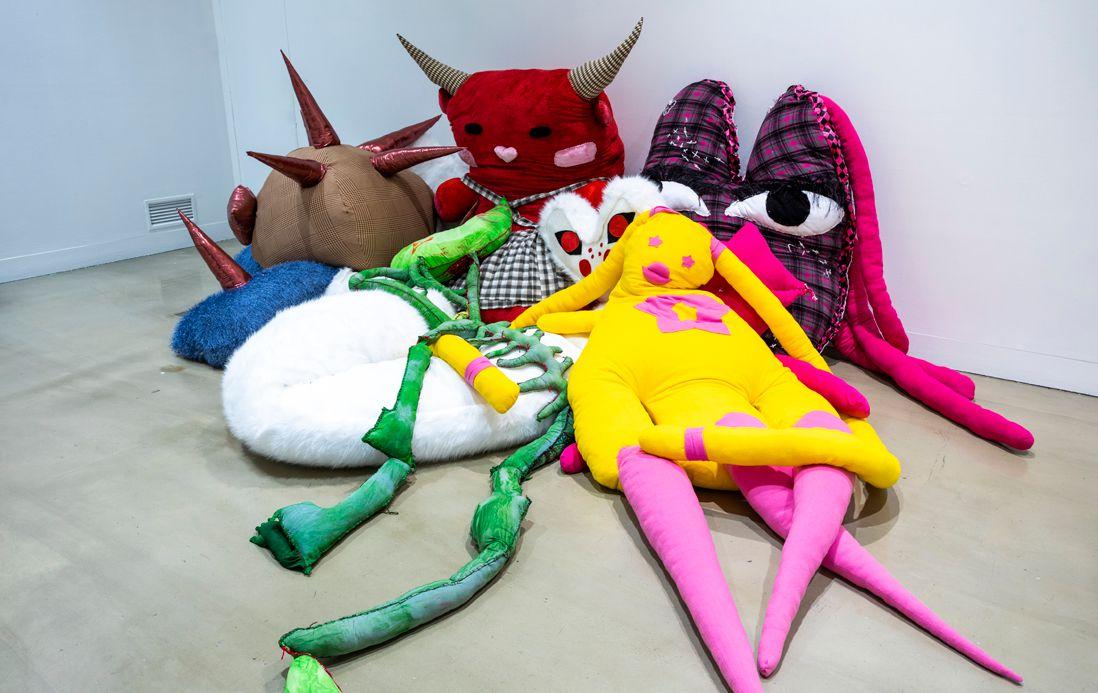
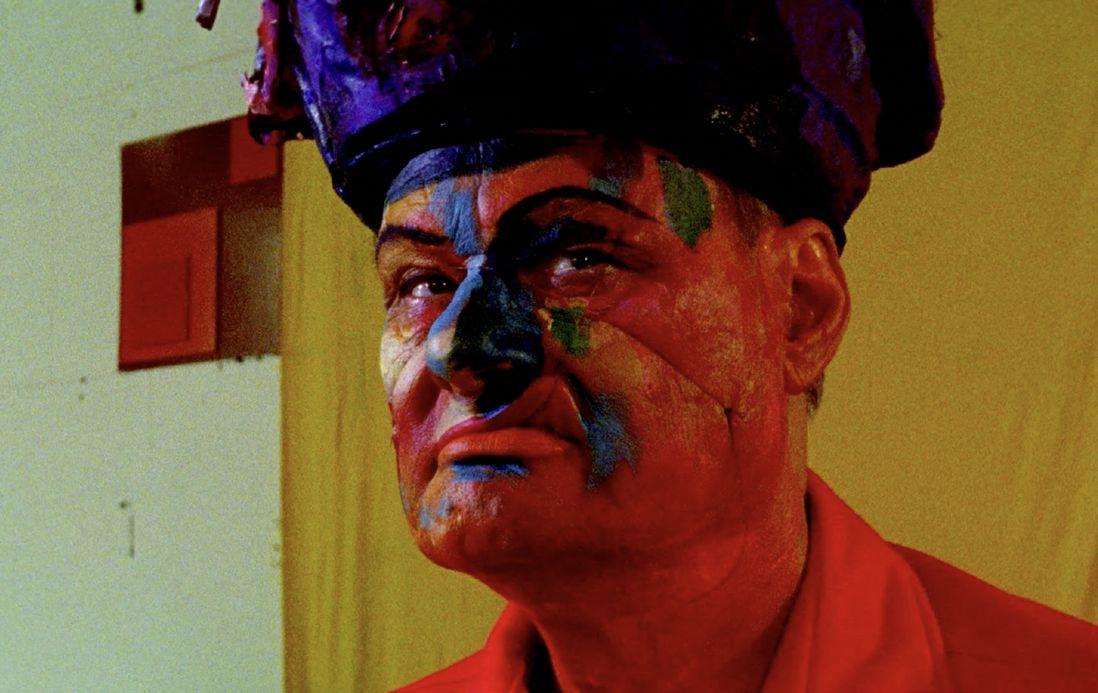
27
(top) The Killing, 6-Pack, 2022, mixed textiles, and synthetic fibres. (bottom) Mike Parr, La Triviata/Bad Son (still), 2010-2013, single-channel video. © Mike Parr. Image courtesy of the artist, and Anna Schwartz Gallery.
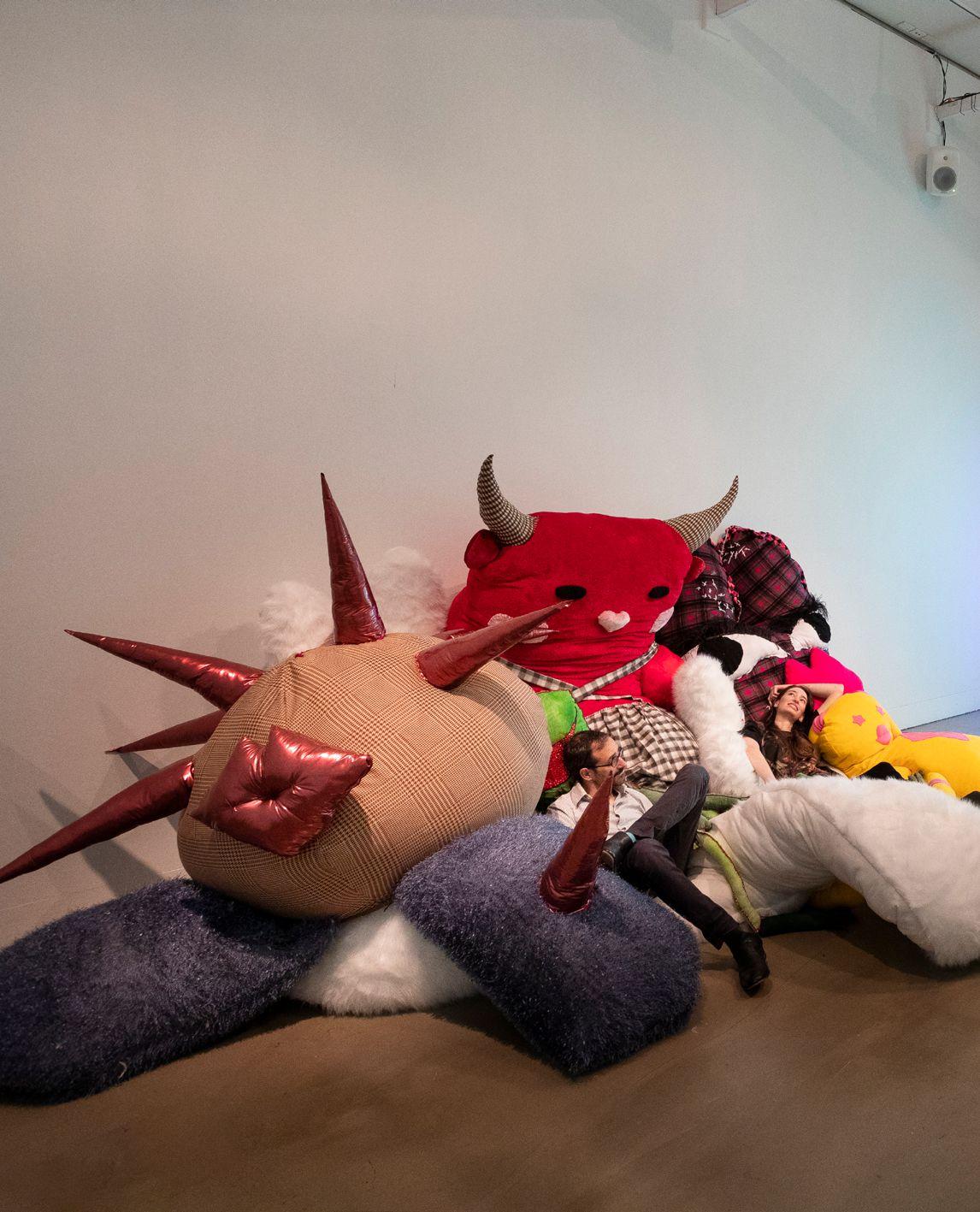
Agent Bodies
Installation image, Agent Bodies, 2022, RMIT Gallery. Image includes works by The Killing, and Mike Parr.

29
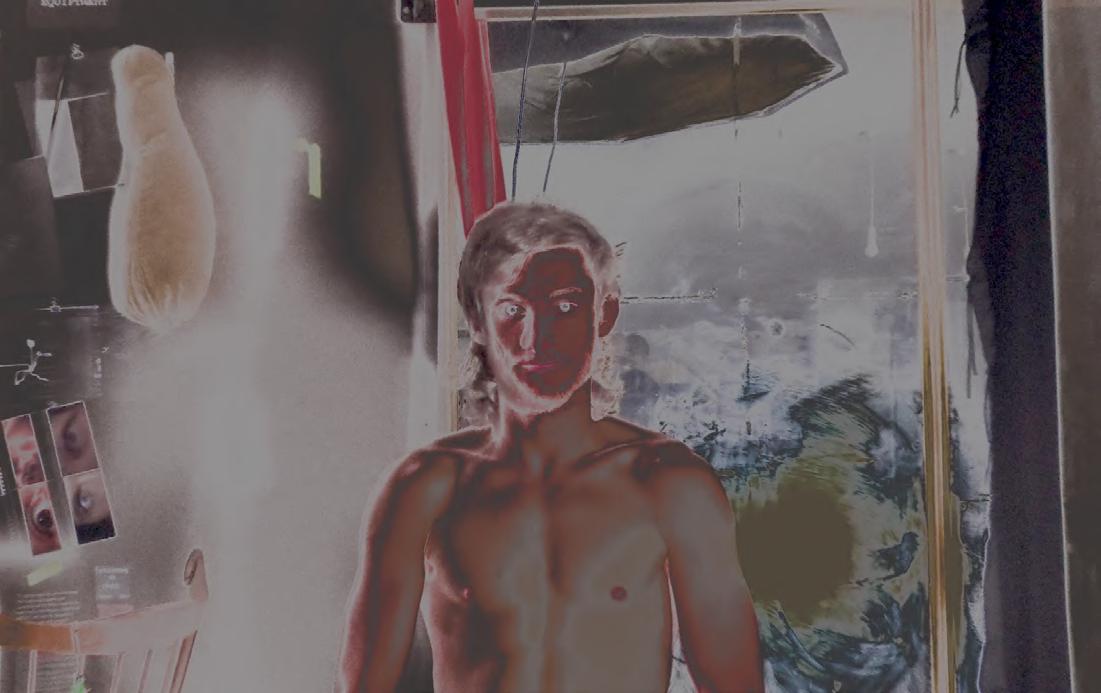
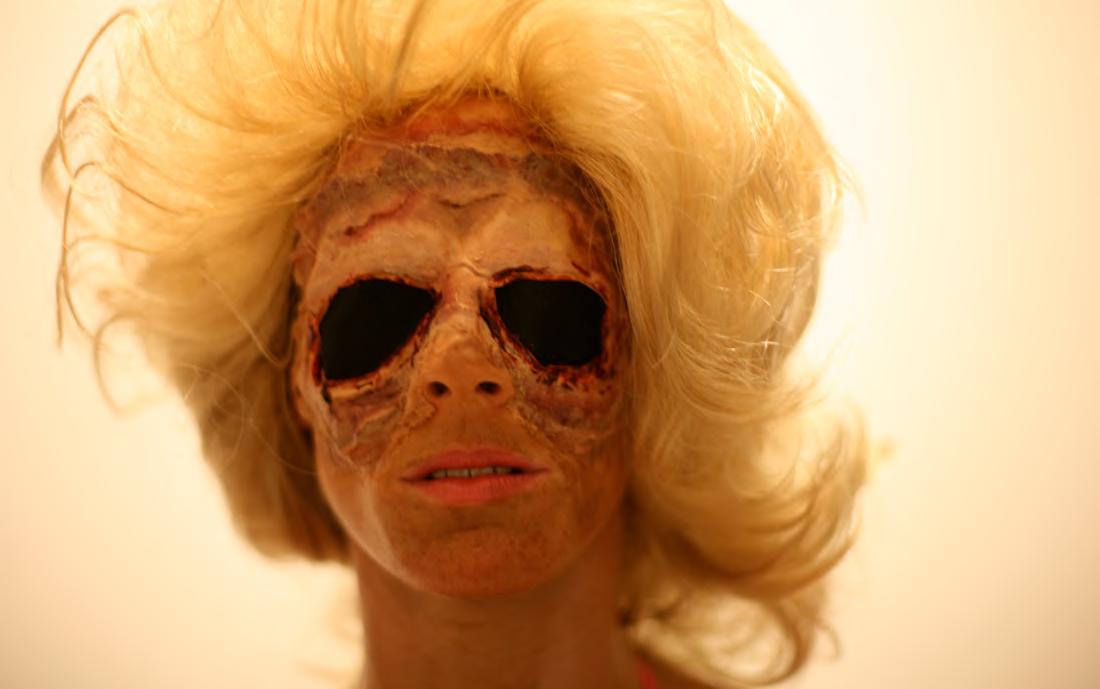
Bodies
Agent
(top) Cassils, Hard Times (Franklin Furnace Movement Research, Brooklyn, NYC), 2011-13. Photo: Heather Cassils with Luke Gilford. Image courtesy of the artist. (bottom) Claire Lambe, I Just Can’t Help Myself I (still), 2020-2021, digital video. Video sound collaboration: Daniel Jenatsch. Image courtesy of the artist, and Sarah Scout Presents.
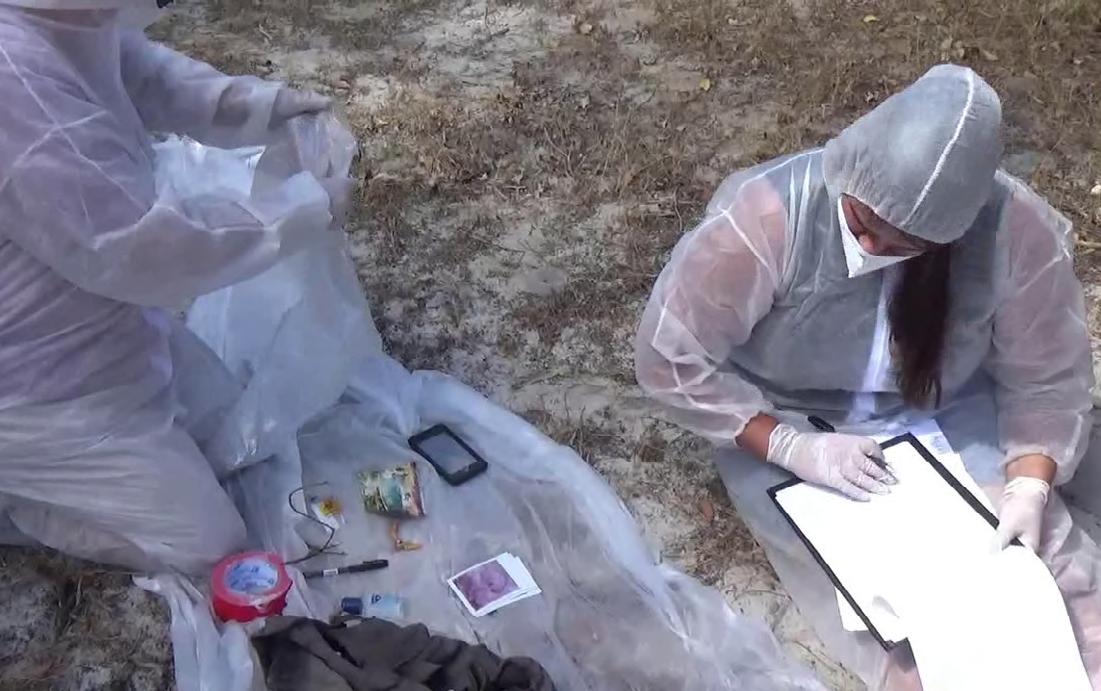
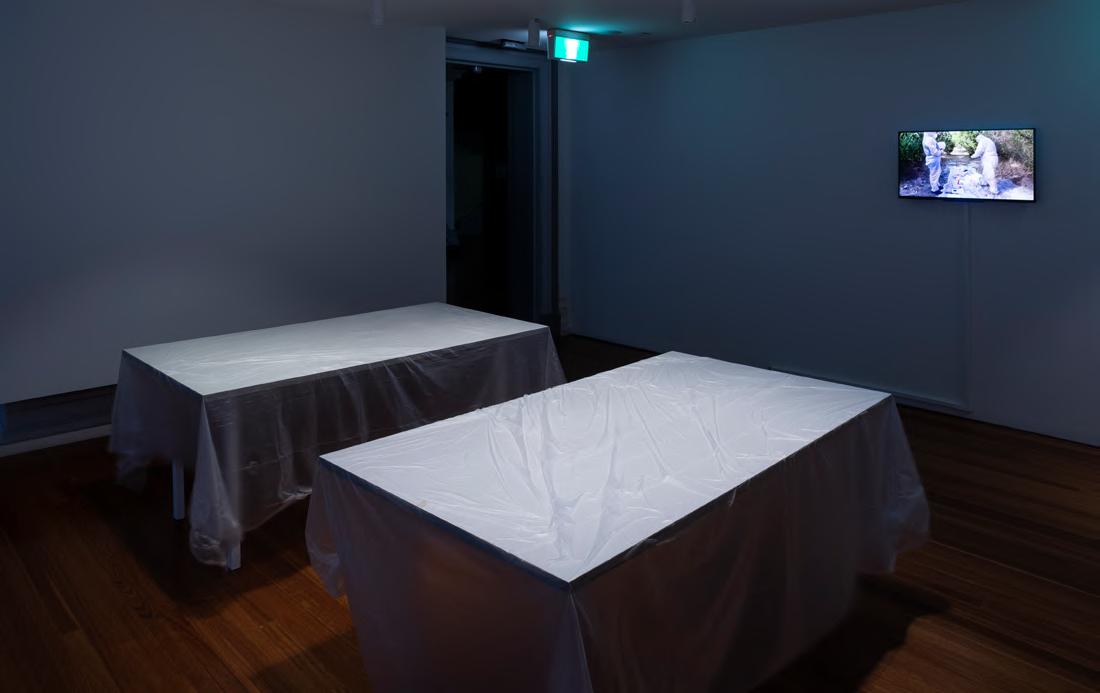
31
(top) Anonymous, J.Doe, 2022, pieces of the artist’s body, clothing and personal artefacts of the artist, letters from the artist, and digital video.
(bottom) Anonymous, J.Doe (still from digital video component of installation), 2022, digital video. Image courtesy of the artist.
Biographies Artists
Brook Andrew
Brook Garru Andrew is an artist and scholar who is driven by the collisions of intertwined narratives, often emerging from the mess of the “Colonial Hole”. His artworks, museum interventions and curatorial projects challenge the limitations imposed by power structures, historical amnesia, stereotyping and complicity to centre Indigenous perspectives. He was artistic director of NIRIN, the 22nd Biennale of Sydney, 2020. In addition to his artist practice, Andrew’s current projects include the co-curation of We Are Not All Just Human After All: Care, Repair, Healing scheduled to open in September 2022 at the Martin-Gropius-Bau, Berlin, Germany; International advisor to the Nordic Pavilion being transformed into the Sámi Pavilion at the 59th International Art Exhibition of La Biennale di Venezia 2022, Venice, Italy; Associate Researcher, Pitt Rivers Museum, Oxford, United Kingdom; and the ARC project More than a guulany (tree): Aboriginal knowledge systems with co-investigator Professor Brian Martin. Brook Andrew is represented by Tolarno Galleries, Melbourne; Roslyn Oxley9 Gallery, Sydney; and Galerie Nathalie Obadia, Paris and Brussels.
Anonymous
The artist is based in Australia and is of First Nations origin. The artist has performed and presented work both nationally and internationally. The artist’s work explores duration and ritual as both a lifestyle and artistic practice.
Georgia Banks
Georgia Banks’ works begin with an invitation and a provocation. Sometimes they are met with an overwhelming response, sometimes no one answers at all. She does not value either of these outcomes over the other. In recent years she has been banned from Tinder, sued by the estate of Hannah Wilke, and awarded Miss Social Impact in a national beauty pageant. She would like to go viral, become a reality TV star, and be inaugurated into the Guinness World Records Hall of Fame. She has never had a filling nor broken a bone (although she has been crucified) and once was convinced she had accidentally sliced away a part of her labia during a performance (she hadn’t). Banks completed a Masters of Fine Arts by research at the Victoria College of the Arts in 2015, and is a studio artist at Gertrude Contemporary, Melbourne, 2019-2022.
Agent Bodies
B R OOK
GEORGIABA N SK
ANONYMOUS
A NDREW
Leigh Bowery
Leigh Bowery was a fashion designer and performance artist who contributed extraordinarily to the visual culture of the 1980’s and 1990’s. Bowery’s practice presented his own body as his primary medium—a living artwork. He emphasised, distorted and reinvented his body using clothing, costume accessories, make-up and prosthetics. Born in Sunshine, Victoria, Australia in 1961, Bowery emigrated to London in 1980 at the height of the postpunk era and rapidly positioned himself at the centre of the city’s club scene, meeting and working with some of the most influential artists, designers and filmmakers of the time.
Bowery’s work has been the subject of reverence, inspiration and homage in the worlds of art, fashion, music, pop-culture, club-culture, drag, and dance. Sadly, Bowery died of AIDSrelated meningitis in 1994. His work is held in significant private and public collections. In 2002, Take a Bowery: The Art and (larger than) Life of Leigh Bowery, curated by Gary Carsley was presented at The Museum of Contemporary Art Australia, Sydney.
Cassils
Cassils is a transgender artist who makes their own body the material and protagonist of their performances.
Cassils’ art contemplates the history(s) of LGBTQI+ violence, representation, struggle and survival. For Cassils, performance is a form of social sculpture. Drawing from the idea that bodies are formed in relation to forces of power and social expectations, Cassils’ work investigates historical contexts to examine the present moment. They have had recent solo exhibitions at the HOME Manchester, Manchester, United Kingdom; Station Museum of Contemporary Art, Houston, USA; Perth Institute for Contemporary Arts, Perth; Ronald Feldman Fine Arts, New York City, USA; VCU Institute for Contemporary Art, Richmond, USA; Philadelphia Academy of Fine Arts, Philadelphia, USA; Bemis Center for Contemporary Art, Omaha, USA; MU Eindhoven, Eindhoven, Netherlands. They are the recipient of a 2020 Fleck Residency from the Banff Center for the Arts, Princeton Lewis Artist Fellowship finalist, a Villa Bellagio Rockefeller Foundation Fellowship, a United States Artist Fellowship, a Guggenheim Fellowship and a Creative Capital Award.
SIHT YAW
Megan Cope
Megan Cope is a Quandamooka artist. Her sitespecific sculptural installations, video work, paintings and public art investigate issues relating to identity, the environment and mapping practices. She has featured in the TarraWarra Biennial 2021, Slow Moving Waters, TarraWarra; NGV Triennial 2020, Melbourne; Adelaide Biennial of Australian Art 2020, Monster Theatres, Adelaide; The National 2017, New Australian Art, Sydney; and the 3rd National Indigenous Art Triennial 2017, Defying Empire, Canberra. From 2017 to 2019 Cope was the Official Australian War Artist. Her work is held in Australian and international collections. Cope is a member of Aboriginal art collective proppaNOW, and is represented by Milani Gallery, Brisbane.
33
CASSIL S LEIG H EWOB YR AGEM N COPE
Biographies
Artists cont.
UANDAVILA
Juan Davila
Born in Santiago, Chile in 1946, Juan Davila moved to Melbourne in 1974 and has consistently worked between the two countries since. Davila uses painting to engage in debates around aesthetics, politics and sexuality, drawing on its rich and varied histories in Latin America, Australia, Europe and North America. Davila’s work has been included in the Sydney Biennale, Sydney, 1982, 1984; the Sao Paulo Biennial, Sao Paulo, Brazil, 1998; and Documenta 12, Kassel, Germany, 2007. Major retrospective surveys of his work have been held at The Museum of Contemporary Art, Sydney, 2006; and the National Gallery of Victoria, Melbourne, 2007. Davila’s work is held in every major museum collection in Australia, as well as significant international museums, including the Metropolitan Museum of Art, New York, USA; Reina Sofia Museum, Madrid, Spain; and the Tate, London, United Kingdom.
Matthew Davis
MATTHEWDA
Matthew Davis is an Australian artist working with sound. Since 2016, Matthew has been a member of the Management Committee of Melbourne’s Living Museum of the West in Maribyrnong, Victoria, and along with others has contributed to the digitisation of the Museum’s oral history collections and developed programs and exhibitions that document and interpret aspects of the natural, lived and built histories of Melbourne’s inner west, including: The Archival Reflex (with Susan Long), 2017; Groundwork, 2018; You are Here, 2019; and Rivers and Streams, 2020-21.
ANKOVICH
AICILA
Alicia Frankovich
Alicia Frankovich was born in Tauranga, Aotearoa New Zealand and lives and works in Melbourne on Wurundjeri Country. Frankovich is interested in the potential for new modes of imagining bodies, their behaviours and environments, both human and non-human, as well as questions of the whole subject or whole earth. She has held solo exhibitions and staged performance commissions including AQI2020, Auckland City Art Gallery Toi o Tāmaki, Auckland, New Zealand; The Work, Kaldor Public Art Projects, The Art Gallery of NSW, Sydney; Exoplanets, Monash University Museum of Art, Melbourne; Atlas of the Living World, Stedelijk Museum, Amsterdam, The Netherlands, and at Liquid Architecture x RMIT Design Hub Gallery, Melbourne; After Blue Marble, KUB Billboards, Kunsthaus Bregenz, Austria; OUTSIDE BEFORE BEYOND, Kunstverein für die Reinlande und Westfalen, Düsseldorf, Germany. Frankovich is currently a recipient of an Australian Postgraduate Award for her PhD at Monash University, Melbourne. Alicia Frankovich is represented by 1301SW, Melbourne.
Agent Bodies
J
F R
V I S
Lucian Freud
Lucian Michael Freud was a British painter, with a career spanning over six decades, specialising in figurative nudes. He is known as one of the foremost 20th-century English portraitists. His works are noted for their psychological penetration, deep introspection, and often discomforting examination of the relationship between artist and model. Freud worked from life studies and was known for asking for extended, punishing sittings from his models. Freud’s works are held in significant private and public collections, including Art Gallery of South Australia, Adelaide; Art Gallery of Western Australia; Queensland Art Gallery | Gallery of Modern Art, Brisbane; National Gallery of Australia, Canberra; The Museum of Modern Art, New York, USA; Museo Thyssen Bornemisza, Madrid, Spain; Museum für Gegensartkunst, Siegen, Germany; Pompidou Centre, Paris, France; The Tate, London, England; and The Victoria and Albert Museum, London. Born in Germany, Freud lived and worked in England, after his family emigrated in 1933 to escape the rise of Nazism.
The Killing
The Killing is a composition of collective bodies, and these bodies happen to be friends forged in the false fleeting flames of an institution placed on postcolonial Ngāti Whātua Ōrākei whenua. The organs of this conglomerate— the individual practitioners themselves—often investigate and regurgitate, swallow and then re-birth ideas regarding some form of ‘bodyconstruction’, in the pursuit of resistance towards structures such as techno-capitalism, postcolonialisms. They de/re/ construct what it means to walk, perform, style, dress, construct, sew, photograph, paint, collage, document, design, edit, publish and exist within Aotearoa’s anthropocene. Recent exhibitions include NUISANCE, RM Gallery, Tāmaki Makaurau/ Auckland, New Zealand, 2021. The Killing are P.A., Daniella Bay, Venus J Blacklaws, Tristan Bloemstein, Minsoh Choi and Meleseini Faleafa.
LUCIA N DUERF
Claire Lambe
Melbourne-based artist Claire Lambe draws from film, music, and traditional sculptural practice to create psychologically complex spaces that invite speculation on the human body as both matter and intermediary. Raised in Macclesfield, North of England in the 1970s, Lambe acknowledges the complexity of leaving, a probing flirtation between transformation, hostility, and tenderness. Lambe trained as a traditional sculptor, and holds degrees from Bristol College of Art, Bristol, United Kingdom; University of New South Wales, Collage of Fine Arts, Sydney; and Goldsmiths, London, United Kingdom. Recent major exhibitions include, The Body Electric, National Gallery Australia, Canberra, curated by Shaune Lakin and Anne O’Hehir in 2020; From Will to Form, Tarrawarra Biennale, curated by Emily Cormack in 2018; and Mother holding something horrific, Australian Centre for Contemporary Art, Melbourne, curated by Annika Kristensen and Max Delany in 2017. Lambe was awarded the Australia Council, ACME International Residency, London, United Kingdom, 2018; and the Edwards Trust award, ISCP, New York, USA, 2015/2016.
35
CL AIRE L
A EBM THEKI L GNIL
Biographies Artists cont.
Mike Parr
Mike Parr continually questions the possibilities and critical reception of contemporary art. Exploring the limits of his physical and mental capacity, Parr’s performance practice employs his own body to examine identity and political conventions of the Twentieth Century. By subsuming modes of activism into his practice and working beyond established structures, Parr rigorously examines aesthetic norms and social circumstances. Parr’s works have been exhibited in Australia and internationally, including in Brazil, Cuba, France, Germany, Hungary, Japan, Korea, Taiwan and the USA. Mike Parr is represented in the 23rd Biennale of Sydney, 2022. Mike Parr is represented by Anna Schwartz Gallery.
Sam Peterson
Sam Petersen is a thirdgeneration white settler of German and English descent. Sam lives and works by the Birrarung, on the stolen lands of the Wurundjeri people.
Sam Petersen says of Sam’s work: ‘I’m interested in what can be done with one’s identity and the space around it. Both body and mind, touching everyday feelings between the rational, the playful and the political. Of course, this is often to do with my disability and my sexuality. My work has been focused on access, and the lack of it—to places, people’s minds and opportunities. I find plasticine is a great subverter of space and potentially of people’s minds. And the continued flexibility of it is something I am really enjoying—covering or filling up gaps and playing with crevices.
I also use words which I call ‘rants’ alongside my visual art and as stand-alone works.’
Yhonnie Scarce
Yhonnie Scarce was born in Woomera, South Australia, and belongs to the Kokatha and Nukunu peoples. Scarce’s interdisciplinary practice explores the political nature and aesthetic qualities of glass and photography. Her work often references the on-going effects of colonisation on Aboriginal people; in particular her research has explored the impact of the removal and relocation of Aboriginal people from their homelands and the forcible removal of Aboriginal children from their families. Family history is central to Scarce’s work, drawing on the strength of her ancestors, she offers herself as a conduit, sharing their significant stories from the past. Scarce has been recognised with a major survey exhibition at the Australian Centre for Contemporary Art, Melbourne, and the Institute of Modern Art, Brisbane, in 2021, with works spanning the past fifteen years of her career. Scarce’s work is held in major collections around Australia. Yhonnie Scarce is represented by THIS IS NO FANTASY, Melbourne.
Agent Bodies
Ah Xian
Ah Xian works with a diverse range of materials including concrete, resin-fibreglass, cloisonné, jade and Ox-bone inlay, bronze, porcelain and latex in the creation of his sculptures. Xian’s practice maintains an ongoing and unrestricted exploration of the human form as a cultural, historical and reflective entity. He has held retrospective exhibitions at Hamilton Gallery, Victoria, 2016; and Queensland Art Gallery | Gallery of Modern Art, Brisbane, 2003; and numerous solo exhibitions in Australia and internationally. His works are held in national and private collections in Australia, North America, East Asia and Europe. Xian was the recipient of the inaugural Australian National Sculpture Prize, National Gallery of Australia, Canberra, 2001; the Clemenger Contemporary Art Award, National Gallery of Victoria, Melbourne, 2009; and received an Australia Council Fellowship, 2002-2004.
Anne Wallace
Anne Wallace’s paintings portray scenes of faint familiarity, evoking feelings of nostalgic longing that are unsettled by the eerie nonchalance of the subjects and their set-like surrounds. Wallace studied painting at Queensland University of Technology, Brisbane. She received an MA from the Slade School of Art in London in 1996, having been given the opportunity to study there via an Anne and Gordon Samstag International Visual Arts Scholarship. Her work was the subject of a major survey exhibition, Strange Ways, curated by Vanessa van Ooyen at QUT Art Museum in 2019, Brisbane, and is included in the collections of National Gallery of Australia, Canberra; Queensland Art Gallery | Gallery of Modern Art, Brisbane; Queensland University of Technology, Brisbane; National Gallery of Victoria, Melbourne; Brisbane City Art Gallery, Brisbane; Toowoomba Regional Art Gallery, Toowoomba; and Macquarie Bank Collection, Sydney. Anne Wallace is represented by Darren Knight Gallery, Sydney; and Kalli Rolfe Contemporary Art, Melbourne.
37
A H NAIX ANNE ECALLAW MIKE
S A MNESRETEP YHONN I E ECRACS
P A RR
Susan Best
Susan Best is an art historian with expertise in modern and contemporary art. She is a fellow of the Australian Academy of the Humanities. Her book Visualizing Feeling: Affect and the Feminine Avant-garde (2011) won the Australian and New Zealand Art Association prize for best book. Her book Reparative Aesthetics: Witnessing in Contemporary Art Photography (2016) was the joint winner of the same prize five years later. Best has just completed a book on body art and performance. Currently, she is working on a history of Indigenous Art in Southeast Queensland with Dr Bianca Beetson.
Edward Colless
Dr Edward Colless is the editor-at-large for the Art+australia journal and A+a publications. He previously worked as the Senior Lecturer in Art at the Victorian College of the Arts, University of Melbourne, lecturing in art and cultural history, aesthetics, cinema studies, and design with practical teaching in performance. Colless writes across art criticism and journalism, book and film reviewing, fiction and travel. An anthology of his selected writing, The Error of My Ways (1995), was nominated for the NSW Premier’s Prize for Literature. Colless has also been shortlisted for the Pascall Prize for Criticism. He has been features writer and associate editor of Australian Art Collector since its inauguration and has worked as Melbourne art reviewer for The Australian newspaper. He has received numerous grants for critical writing from the Australia Council, the latest of which has been in support of a two-volume project titled Hallucinogenesis, which deals with performativity and possession in art.
Agent Bodies Writer Biographies
Mikala Dwyer
Mikala Dwyer’s compounds invite open-ended interaction and take the viewer across boundaries of time, space and geography. While playful and exuberant on the surface, they almost always impel us to imagine something darker beneath—or above. Emerging from a deep and disobedient engagement with modernist form and space, Dwyer’s works have relationship at their heart and have been described as ‘profoundly sociable’. Her many exhibitions internationally include Ichiahara Art + Mix Triennale, Japan, 2020; Blessed Be, MOCA Tucson, USA, 2018; The End of the 20th Century, The Best is Yet to Come—A Dialogue with the Marx Collection, Hamburger Bahnhof, Berlin, 2013; and shows at The Graz Museum, Austria; Zachęta National Gallery of Art, Warsaw; and Chapter Arts Centre, Cardiff, United Kingdom. Her work has been selected for the Istanbul Biennale, 1995; the Biennale of Sydney, 2010 and 2014; and the Adelaide Biennial of Contemporary Australian Art, 2010 and 2020.
Drew Pettifer
Dr Drew Pettifer is a Senior Lecturer in the School of Art at RMIT University where he currently leads the Bachelor of Arts (Fine Art) Hong Kong program. With a background as an artist, curator and lawyer, his research interests include: the body, queer theory, gender, power, desire, representation, the archive, and contemporary social politics. His art practice works across photography, video, printmaking, performance, and installation. More recently his practice has operated at the nexus of creative practice, critical theory, and social justice, aiming to transform our understanding of Australian history by using creative practice to foreground critical queer histories which have been systematically excluded from dominant archives.
39
Curator Biographies
Exhibition staff
Manager Creative Production
Helen Rayment
Strategic Planning Manager
Verity Hayward
Senior Curator
Andrew Tetzlaff
Exhibition Officer
Sarah Werkmeister
Curatorial Assistant Michaela Bear
Production Coordinator
Erik North
Production Officer
Tim McLeod
Production Officer (Sound)
Simon Maisch
Production Assistants
Robert Bridgewater, Mason Cox, Nikolaus Dolman
This publication has been published on the occasion of the exhibition Agent Bodies, curated by Mikala Dwyer and Drew Pettifer. Agent Bodies is an RMIT Gallery project and a part of the RMIT Culture program which occurred from 8 April to 14 August 2022.
RMIT Gallery would like to acknowledge the curators and artists for their involvement in the project, as well as the generous loans from private collections and the Estate of Leigh Bowery. Further, a special thanks to the following individuals for their assistance: Margery King, Curator, Estate of Leigh Bowery; Nicola Bateman; and Dr Michael Shiell, Arts and Culture Coordinator, City of Brimbank.
The curators would like to thank the participating artists and contributing writers for their involvement and dedication, as well as RMIT Gallery for the opportunity to present this project. They would also like to acknowledge the support and commitment of RMIT Culture and the RMIT Gallery team, and the generosity and enthusiasm of our project sponsors and supporters. Finally, they would like to extend thanks to Professor Tom Bentley, Executive Director, Policy and Impact; Paula Toal, Head, RMIT Culture; and Professor Tim Marshall, Deputy Vice Chancellor and RMIT Vice President.
Published May 2022 Design by Lachlan Siu
Contributing Writers: Susan Best and Edward Colless.
Agent Bodies
Photography of Anne Wallace’s Pythoness (2022) on page 16 by Kalli Rolfe Contemporary Art.
Photography of Cassils’ Hard Times (Franklin Furnace Movement Research, Brooklyn, NYC) (2011-13) on page 30 by Heather Cassils with Luke Gilford.
All other exhibition installation photography by Tobias Titz, 2022.
All images courtesy the artists and their representatives. This catalogue is copyright. Apart from fair dealings for the purpose of research, criticism or review as permitted under the Copyright Act 1968. No part may be reproduced, stored in a retrievable system or transmitted by any means, without the prior permission of the publisher.
The views and opinions expressed in this catalogue are those of the authors and do not necessarily reflect the official policy or position of RMIT University.
RMIT Gallery
RMIT University 344 Swanston Street, Melbourne Victoria 3000, Australia Web: www.rmitgallery.com Social media: @rmitgallery Tel: +61 3 9925 1717
Email: rmit.gallery@rmit.edu.au
RMIT University acknowledges the people of the Woi wurrung and Boon wurrung language groups of the eastern Kulin Nations on whose unceded lands we conduct the business of the University. RMIT University respectfully acknowledges their Ancestors and Elders, past and present. RMIT also acknowledges the Traditional Custodians and their Ancestors of the lands and waters across Australia where we conduct our business.
41
Agent Bodies
08.04.22 — 14.08.22



 Agent Bodies
Installation image, Agent Bodies, 2022, RMIT Gallery. Image includes works by Yhonnie Scarce, Lucian Freud, Leigh Bowery, Sam Peterson, Megan Cope, Alicia Frankovich, and Brook Andrew.
Agent Bodies
Installation image, Agent Bodies, 2022, RMIT Gallery. Image includes works by Yhonnie Scarce, Lucian Freud, Leigh Bowery, Sam Peterson, Megan Cope, Alicia Frankovich, and Brook Andrew.




 Anne Wallace, Infanta, 2021, Oil on linen. Image Courtesy of the artist, and Darren Knight Gallery.
Anne Wallace, Infanta, 2021, Oil on linen. Image Courtesy of the artist, and Darren Knight Gallery.

 Agent Bodies
(top) Megan Cope, THE BLAKTISM (still), 2014, digital video. Image courtesy of the artist, and Milani Gallery.
(bottom) Anne Wallace, Pythoness (detail), 2022, oil on linen. Image courtesy of the artist, and Kalli Rolfe Contemporary Art.
Agent Bodies
(top) Megan Cope, THE BLAKTISM (still), 2014, digital video. Image courtesy of the artist, and Milani Gallery.
(bottom) Anne Wallace, Pythoness (detail), 2022, oil on linen. Image courtesy of the artist, and Kalli Rolfe Contemporary Art.




 Agent Bodies
Sam Petersen, Just Sit, 2022, chair, plasticine, and plastic.
Agent Bodies
Sam Petersen, Just Sit, 2022, chair, plasticine, and plastic.













